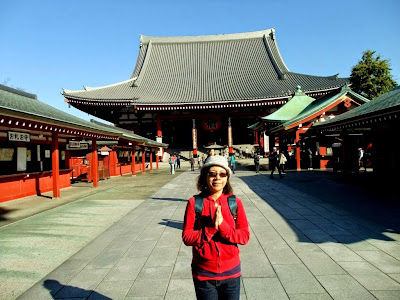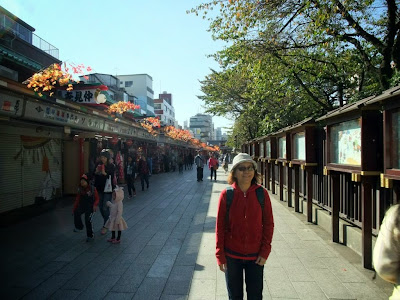
Asakusa District in Central Tokyo is a lively place where people experience a more traditional life style of Tokyo under an old Edo Downtown atmosphere. The area used to be a site of Kabuki Theaters and leading entertainments with large red light district in 17th century. During 18th to 19th centuries, entertainments changed to modern movie theaters. Asakusa is a very convenient spot for accommodation, dinning, sight seeing and meeting friends. The main purpose of our coming to Tokyo this time is to visit one of our old friends, who had shared part of our life history in the past 20 years. There are too many returns of those days to recall. The place though bustling, is still the most ideal place to hang around with him for our short stay in Tokyo.



Asakusa Kannon Temple situated at the center of Asakusa District is the main attraction and an outstanding landmark in the area. Its entrance gate Kaminarimon literally means Thunder Gate is the symbol of Asakusa and Tokyo. There are two gate protectors on its left and right, in which, one is God of wind called Fujin and the other God of Thunder called Raijin. Being first established in 7th century, Kannon Temple is considered the oldest in Tokyo and one of the most significant in Japan.


Hozoman is the second gate towards Sensoji's main shrine hall. Asakusa Kannon Temple was built in dedication to Bodhisattva Avalokitesvara (Goddess of Mercy). The legend said that the statue of Kannon (Goddess of Mercy) was found by two brothers named Hinokuma and Takeyari Hamanari in year 628. They were fishermen. The head of the village recognized its sanctity and remodeled his own house as a little shrine to house the image for villagers to worship. It was said that the image of Bodhisattva remains at the spot ever since but we were not sure whether the golden image of Bodhisattva enshrined in the main shrine hall is the originals or a different one.


The present structure of Sensoji's main shrine hall dated from 1950s, had just gone through another renovation in end 2010. The old structure was destroyed in World War II.


The 55 meter high five tiers pagoda standing on the left side of the Main Shrine Hall is impressive.



Devotees burn incense into this large incense cauldron and get the smoke which is believed to have blessing on one's health.


To clean hands and mouth before entering the sacred shrine are customs in all Japanese temples. Before cleansing, I paid homage to the dragon king to request for a non-raining weather during my stays in Japan. In Buddhism or Taoism or Chinese cultural beliefs, Dragon Kings are the controller of water.


A golden image of Guanyin (Goddess of Mercy) is enshrined inside the hall.


The ancient stone carved images in the temple surroundings are Amitabha Buddha and Earth-Stored Bodhisattva Dizang, representatives of Pure land Buddhism. I knelled and bowed to each of them.



Between the offering structures and blessing lanterns, there is an unique stone statue in appearance of a mother with two kids. Name written underneath was "Dizang of Mother and Son". We never see such posture of Dizang in any other part of the Buddhist Temples.



The 5-tiers pagoda when lit up at night is gorgeous.



Asakusa Kannon Temple at night.






The dramatically painted massive paper red lanterns are attractive, so is the representative straw shoe of the monk, which I believed is an auspicious offering in the pasts.



The 260 meter long Nakamise shopping street is a bridge that connect the busy people with the holy temple.


The Nakamise-dori precinct shopping street leading from the outer gate to Temple's 2nd gate, are lined up with small shops and stalls, providing varieties of tradition local snacks, typical Japaneses souvenirs like yukata, kimono, fans and some Edo crafts. I love their snacks especially those made with persimmon and chestnut. We are advised not to eat the snacks while walking on the street, most probably I think it is a kind of respect to the religious site.


Nakamise shopping street has a history of over several centuries. It was believed that the place began to exist in early 18th century but destroyed in 1923 earthquake. The site was restored with concrete structures two years later but during World War II, it was once again destroyed. The current shopping street with 89 shops were rebuilt in 1950s.


Standing over the other bank of Sumida River, next to this ancient cultural and religious site where copying Sutra to offer to Buddha is still in a practice, is the latest and highest modern building of Tokyo Skytree, though clashing in interest yet no conflict in existence.


All Japanese mother who accompanied their children to attend religion ceremony in The Temple Hall wear Kimono. They look elegant and beautiful.



As one of the autumn activity, various species of chrysanthemum flowers are on exhibition at Asakusa Kannon Temple site.



No comments:
Post a Comment